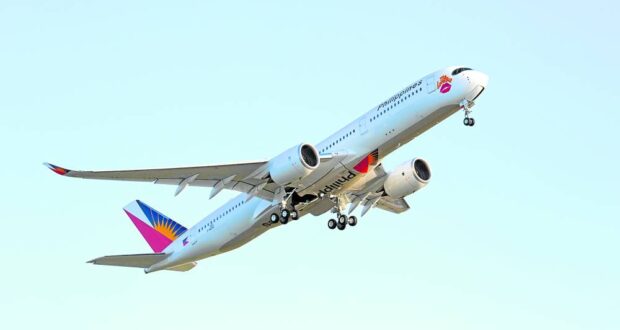
TAKEOFF Despite challenges, Philippine Airlines remains bullish on its growth prospects this year. —FILE PHOTO
MANILA -Persistent supply chain woes and competition with global carriers for spare parts and planes continue to ground Philippine Airlines’ (PAL) postpandemic growth plans amid resurgent air travel demand.
The flag carrier, controlled by taipan Lucio Tan, is maintaining a positive outlook for the year, especially with the anticipated full reopening of China, but supply chain bottlenecks remain a challenge, PAL president Stanley Ng said.
He said PAL, which successfully emerged from a brief US bankruptcy process during the global health crisis, is also facing obstacles in expanding its widebody fleet for long-haul trips.
“If we can get more planes we can expand immediately but we can’t,” Ng, who is also a commercial airline pilot, told reporters in a recent chance interview.
Like other airlines, PAL scaled down its fleet during the pandemic and returned several planes to lessors, including four out of six Airbus A350-900s that are capable of mounting nonstop flights from Manila to New York.
Getting the planes back has been difficult and the soonest they can acquire brand new aircraft is in 2025, Ng said.
“There’s a plan to finalize [new orders] but it will take two years to deliver the aircraft,” he said, adding that PAL is considering acquiring A350s and Boeing 777 planes.
Buying used aircraft was also not an option due to the cost and time needed to reconfigure the interior of the planes to fit their business model, he added.
As a result, PAL would not be launching new long-haul routes this year.
The lack of aircraft and parts can also cause operational issues such as flight cancellations apart from in-flight inconveniences such as busted tray tables and seat recliners. Ng said they were working to resolve those issues with their suppliers.
New investors
“There is competition [with other airlines] so the relationship with suppliers and manufacturers is important,” he said.
The revenge travel trend, spurred by fading pandemic fears and relaxed movement restrictions, has lifted the airline industry from the pandemic slump.
In fact, the International Civil Aviation Organization is forecasting passenger demand to “rapidly recover” and exceed prepandemic air traffic by 3 percent this year.
PAL was no exception as operating income turned positive for the first time in three years, reaching $297.3 million in 2022.
Over the next five years, Ng said PAL plans to acquire 10 more planes, although he did not elaborate.
This will bring its fleet size to about 80 aircraft after some of its older jets are retired. Before its restructuring in 2021, the PAL Group had 95 planes.
With the flag carrier on more stable financial footing, Ng said PAL has been receiving feelers from potential international strategic investors from Hong Kong and China apart from local groups.
He said they remain open to new investors but there were no ongoing talks.
In 2019, Japan’s ANA Holdings acquired a 9.5-percent stake in PAL Holdings, the publicly listed parent firm. ANA’s stake will be reduced to about 4 percent during the parent firm’s restructuring, PAL senior vice president and general counsel Carlos Luis Fernandez said in a text message. INQ
READ MORE:
https://business.inquirer.net/394047/pal-back-in-the-black-after-2021-bankruptcy
https://business.inquirer.net/385153/with-rocky-chapter-behind-it-pal-seeks-to-boost-fleet